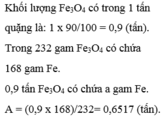Bài 3. a) Tính khối lượng sắt có trong 100 tấn quặng manhetit chứa 69,6% Fe3O4. b) Tính tổng số nguyên tử của các nguyên tố có trong 4,8 gam CuSO4
Hãy nhập câu hỏi của bạn vào đây, nếu là tài khoản VIP, bạn sẽ được ưu tiên trả lời.


a) mFe2O3= 60%.10=6(tấn)
=> mFe= (112/160).6= 4,2(tấn)
b) nH2O=36/18=2(mol)
=> Số mol nguyên tử trong 2 mol H2O là: 2.2+ 2.1=6(mol)
Tổng số nguyên tử của các nguyên tố trong 36 gam H2O là:
6.6.1023=3,6.1024 (nguyên tử)
Chúc em học tốt!

Đổi 1 tấn = 1000 kg
nFe2O3 = 1000 . 90% : 160 = 5,625 (kmol)
nFe = 5,625 . 3 = 16,875 (kmol)
mFe = 16,875 . 945 (kg)

Bài 1 :
Khối lượng FeS thu được sau phản ứng biết lưu huỳnh dư 1,6 g :
mFe = mFe + mS - mS.dư
= 2,8 + 3,2 - 1,6
= 4,4 (g)

Đặt mA = a (tấn); mB = b (tấn)
Giả sử a + b = 1 (tấn) (1)
\(m_{Fe_2O_3\left(A\right)}=a.60\%=0,6a\left(tấn\right)=6.10^5a\left(g\right)\)
=> \(n_{Fe_2O_3\left(A\right)}=\dfrac{6.10^5a}{160}=3750a\left(mol\right)\Rightarrow n_{Fe\left(A\right)}=7500a\left(mol\right)\)
\(m_{Fe_3O_4\left(B\right)}=b.69,6\%=0,696b\left(tấn\right)=696.10^3b\left(g\right)\)
=> \(n_{Fe_3O_4\left(B\right)}=\dfrac{696.10^3b}{232}=3000b\left(mol\right)\Rightarrow n_{Fe\left(B\right)}=9000b\left(mol\right)\)
\(n_{Fe\left(tổng\right)}=\dfrac{0,48.10^6}{56}=\dfrac{60000}{7}\left(mol\right)\)
=> \(7500a+9000b=\dfrac{60000}{7}\) (2)
(1)(2) => \(a=\dfrac{2}{7}\left(tấn\right);b=\dfrac{5}{7}\left(tấn\right)\)
=> \(\dfrac{a}{b}=\dfrac{2}{5}\)

Đặt mA = a (tấn); mB = b (tấn)
Giả sử a + b = 1 (tấn) (1)
\(m_{Fe_2O_3\left(A\right)}=a.60\%=0,6a\left(tấn\right)=6.10^5a\left(g\right)\)
=> \(n_{Fe_2O_3\left(A\right)}=\dfrac{6.10^5a}{160}=3750a\left(mol\right)\Rightarrow n_{Fe\left(A\right)}=7500a\left(mol\right)\)
\(m_{Fe_3O_4\left(B\right)}=b.69,6\%=0,696b\left(tấn\right)=696.10^3b\left(g\right)\)
=> \(n_{Fe_3O_4\left(B\right)}=\dfrac{696.10^3b}{232}=3000b\left(mol\right)\Rightarrow n_{Fe\left(B\right)}=9000b\left(mol\right)\)
\(n_{Fe\left(tổng\right)}=\dfrac{0,48.10^6}{56}=\dfrac{60000}{7}\left(mol\right)\)
=> \(7500a+9000b=\dfrac{60000}{7}\) (2)
(1)(2) => \(a=\dfrac{2}{7}\left(tấn\right);b=\dfrac{5}{7}\left(tấn\right)\)
=> \(\dfrac{a}{b}=\dfrac{2}{5}\)

Câu a.
\(M_{Ca\left(NO_3\right)_2}=164\)g/mol
\(m_{Ca\left(NO_3\right)_2}=0,3\cdot164=49,2g\)
\(\%Ca=\dfrac{40}{164}\cdot100\%=24,39\%\)
\(m_{Ca}=\%Ca\cdot49,2=12g\)
\(\%N=\dfrac{14\cdot2}{164}\cdot100\%=17,07\%\)
\(m_N=\%N\cdot49,2=8,4g\)
\(m_O=49,2-12-8,4=28,8g\)
Các câu sau em làm tương tự nhé!

a)
$m_{Fe_3O_4} = 100.1000.69,6\% = 69600(kg)$
$n_{Fe_3O_4} = 69600 : 232 = 300(kmol)$
$m_{Fe} = 300.3.56 = 50400(kg)$
b)
$n_{CuSO_4} = \dfrac{4,8}{160} = 0,03(mol)$
Số nguyên tử Cu = Số nguyên tử S = 0,03.6.1023 = 0,18.1023 nguyên tử
Số nguyên tử O = 0,03.4.6.1023 = 0,72.1023 nguyên tử
a) Khối lượng Fe3O4 có trong quặng là: mFe3O4 = 100* 69,6%= 69,6 (tấn)
-> nFe3O4 = m/M = 69,6 / 232= 0,3 (mol)
-> nFe = 3 nFe3O4 = 0,3*3 = 0,9 (mol)
-> mFe = n*M = 0,9* 56= 50,4 (tấn)
vậy trong 100 tấn quặng manhetit chứa 50,4 tấn Fe